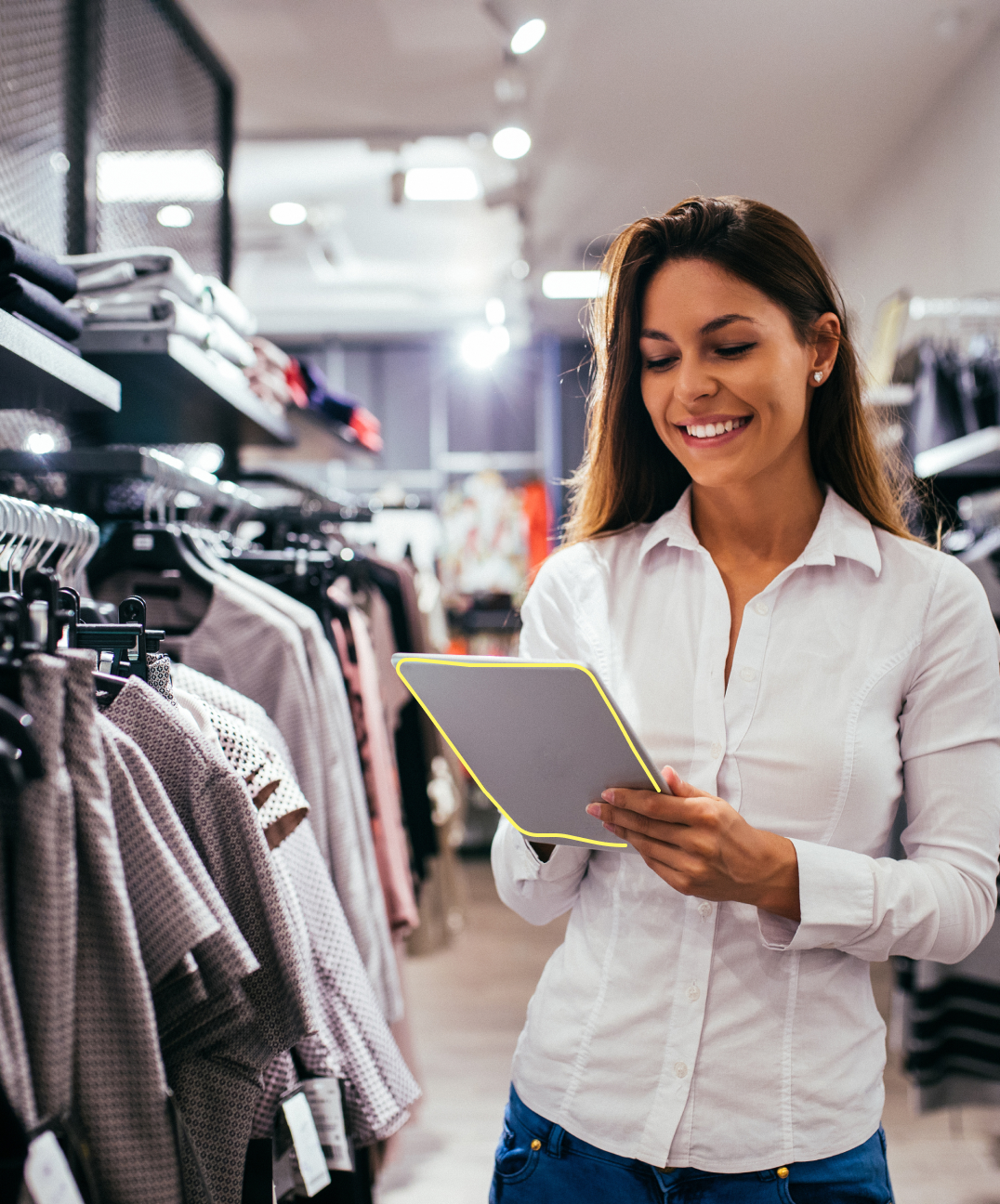Table of contents
To the resourcesMöchten Sie mehr wissen? Vereinbaren Sie ein Beratungsgespräch!
Short and sweet
Connected Store, Connected Retail, digital shopping experience. Many terms - one idea: the Merging digital and physical retailing. There is no need to explain further how important online shopping and an online offering by retailers are in pandemic times. Current regulations and developments speak for themselves.
For this very reason, online and stationary retail must no longer be thought of separately. The "fusion" mentioned must be included and built into the strategies. Zalando - Europe's leading online platform for fashion and lifestyle - is a pioneer here. The company wants to create new connections: from offline to online.
Zalando itself perfectly sums up the quintessence of a Connected Store or Connected Retail:
"Today's customers want a seamless shopping experience. For them, the most important thing is to find the product they want, whether online or offline." - Zalando
If you think about it, it's actually quite logical. Find the product you were looking for. One way or another. The implementation, of course, is far more complex. In this article, we would like to give you an insight into the world of the Connected Store, provide implementation incentives and present a possible solution approach. No two companies are the same. Therefore, there can be no all-encompassing solution as to how you can best close the gap between online and offline.
Stationary trade – soon history?
Before we delve deeper into the subject, we would like to mention stationary retail, brick-and-mortar stores, "physical stores," if you will. Will brick-and-mortar retail soon be history? This is a question that many retailers are rightly asking themselves. Especially those who do not have an online offering.
We think: No! This is because the development of a holistic Connected Store strategy also includes a meaningful, precise localization of the store visit in the customer journey. The right approach also shapes the associated store concept and ensures its relevance. A wisely chosen store vision therefore also has a significant strategic background.
Moreover, physical stores remain the places where the majority of customers buy products for the first time. Because only here can things be tried out, touched, and the quality experienced. Stores have not lost their value to date. And yet: the long-term attractiveness of retailers is not exclusively, but definitely, determined by an existing online offering. As the saying goes: "It's all in the mix!"
The goal
Hybrid sales centers the aim is to create stores where customers can browse and shop as well as order and collect goods via click and collect. Stores are also linked to the online store so that orders can be taken directly from the inventory in the store instead of accessing external warehouses. The prerequisite, of course, is that an online store already exists for the retailer in question. However, since we want to show in this article how you can link online and offline, we will not go into this aspect in more detail. We will explain how you can approach the goal of hybrid sales centers in the following.
The approach
First things first: By linking online and offline, you ensure that the customer never again has to experience a situation in which something is sold out.
The idea of the Connected Store is fundamentally based on four building blocks:
Availability
Selection
Local aspect
Sustainability
Stationary retail must "coordinate" with online retail. Products that are only available online or only offline must no longer be an issue. Even if the brick-and-mortar retail continues to rank first in terms of first-time product purchases, repeat purchases are with the majority online. As Salesforce's Connected Shoppers Report has shown.
But not every customer is the same. If someone prefers to buy a product from a brick-and-mortar retailer, and it is not available locally, satisfaction quickly wanes. It's the same the other way around. So make products from the online store available for pickup in the store. With the keyword Selection, it then also becomes clear why the Availability of products is so important. If a product is available, but the selection of different sizes/models/colors is small, the aspect of availability is almost completely invalid. The customer is annoyed and, in the worst case, switches to a competitor. You have to prevent this!
The third point is the local aspect. Let your customers use a filter in the online store to select only items that can be delivered from a store. This allows you to consciously support brick-and-mortar retail, as well as the chance to receive the delivery even faster, since it comes from a nearby store rather than from a warehouse.
This also affects the fourth point, Sustainability. With features such as Click and Collect, customers can return goods they would otherwise return to the store or reserve an item online and then pick it up later in the store. Services like these eliminate the need to send packages back and forth.
A solution approach: Salesforce for the retail industry
One possible approach to becoming a Connected Store is through Salesforce's CRM system. With an industry-tailored solution, Salesforce's retail solutions can help you connect your customers with the right information. Networking of all channels from hotline to online store to in-store sales, to provide a consistent shopping experience.
So Salesforce connects all your digital and physical retail channels and helps you get a 360-degree view of customers.
There are various solutions that could be considered for you. The most popular products are the Commerce Cloud, Marketing Cloud and Service Cloud. The combination of these three clouds enables you to keep an eye on your customers anytime and anywhere. We would like to introduce you to the Commerce Cloud in particular, but not withhold information on other popular clouds for retailers.
Commerce Cloud helps you grow your online business and improve customer relationships. It includes solutions for mobile commerce, B2C commerce, B2B commerce, order management, and content management. All designed to connect with shoppers anytime, anywhere, online and offline.
The main advantages of the Commerce Cloud are:
Convenient shopping via mobile device
Optimization of the conversion process
Linking your online store with social media
Equipping your service staff with optimal tools
Unified commerce, online & offline
Launch campaigns quickly & easily
Standardization of products/prices/catalogs
Optimization of regularly used B2B functions
Acceleration of the market launch
Visual management of workflows
Automatic processing of payments
Easy management of cancellations and returns
The list could go on and on. All of these benefits work toward one big advantage that will give you a competitive edge eventually: the networking of your online and offline trade towards a Connected Store.
If you would like to learn more about consumer behavior and expectations of retailers, as well as the shift in buying processes, we recommend the Connected Shoppers Report from Salesforce.
Would you also like to become a Connected Store and ensure a seamless link between online and offline for your customers? Contact us and we will show you various possibilities.
Ready for the next project? Let's talk!
We will be happy to assist you in an initial consultation.




